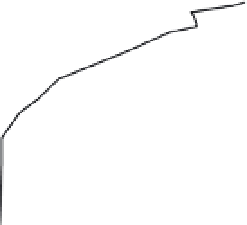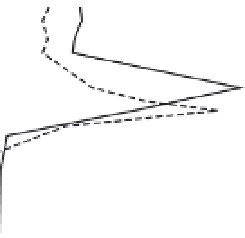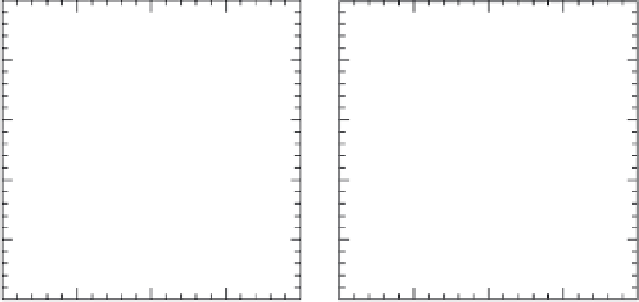Environmental Engineering Reference
In-Depth Information
0
Figure 7.12
Concentration-
depth profiles of (a) tritium
for 1986 and 1991 (Solomon
et al
.,
1993
) and (b) CFC-12
for 1993 (Cook
et al
.,
1995
) in
groundwater at the Sturgeon
Falls site, Canada.
(a)
(b)
5
10
15
1986
1991
20
25
0
50
100
150
200
0 00
200
300
400
500
600
Tr itium concentration (TU)
CFC-12 (pg/kg)
cross-sectional groundwater flow and solute
transport model for the site. A recharge rate of
130 mm/yr produced model results that closely
matched the measured CFC-12 ages.
data, multiple data-collection points are usu-
ally required to determine average drainage or
recharge rates and to assess the variability of
those rates.
Tracer methods can serve as useful comple-
ments to other methods for estimating recharge.
Recharge estimates using environmental or his-
torical tracers often require only a single field
visit to collect soil or water samples; therefore,
tracer methods can be cost effective relative to
water-budget methods (
Chapter 2
) and unsatu-
rated-zone physical methods (
Chapter 5
) that
require instrument installation and mainten-
ance. Tracer techniques generally fail to pro-
vide information on recharge mechanisms and
on the timing of recharge. Because sample col-
lection is not time consuming, reconnaissance
tracer sampling of soil or groundwater can be
used to identify representative sites for applica-
tion of more detailed studies of flow processes
and the temporal variability of fluxes through
the unsaturated zone. In addition, groundwater
ages generated by tracer methods can be used
to improve calibration of groundwater flow
models (
Chapter 3
) that previously relied solely
on hydraulic head data for calibration.
In most tracer studies, the distribution of a
tracer in space or time within the subsurface
is directly measured; however, information
on tracer input and the mechanisms of tracer
movement within the subsurface must often be
inferred on the basis of little or no data. The
accuracy of tracer-based flux estimates depends
7.4 Discussion
Tracer methods can be used in many regions
to estimate recharge. They provide estimates
that are integrated over the time interval from
when the tracer was introduced to the hydro-
logic system to when samples are obtained.
Natural environmental and historical tracers
provide information on cumulative drainage
or recharge over periods of years to millennia.
These tracers are perhaps the most useful tools
available for assessing impacts of long-term
climate variability and land use change on
recharge rates. Chloride is particularly useful
for quantifying low recharge rates in arid and
semiarid regions. Applied tracers generally pro-
vide estimates over much shorter time scales,
days to one or two years. Drainage estimates
within the unsaturated zone, determined by
tracer or other methods, are for a specific point
in space, i.e. they are point estimates. Recharge
estimates based on groundwater data are repre-
sentative of a somewhat larger area, although
the size of that area is largely unknown and
likely varies with location within an aquifer.
Regardless of whether estimates are generated
from unsaturated-zone data or groundwater




































